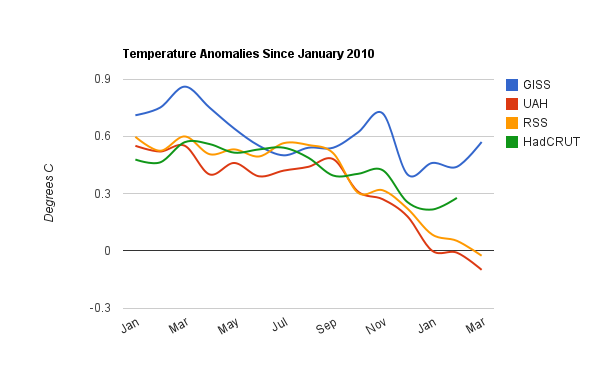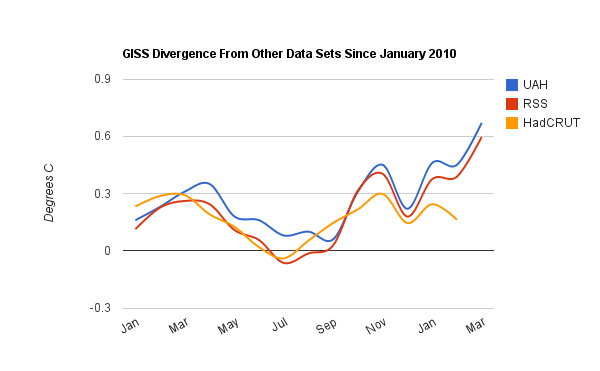Incredibly, GISS has higher temperature anomalies now than they did in the middle of last year’s El Nino summer. (Temperatures lag ENSO by several months.)
Since last summer, GISS has been diverging from satellite data at a rate of over 50C per century. Hansen claimed a record last year by 0.01C – with an error 500X times greater than his claim.
Since 2000, GISS has been diverging from HadCRUT at a rate of 1C per century
Each month, Hansen keeps bumping the Arctic (where he has almost no data) further and further into fantasy land. How long will this game go on?
Muller claims the surface temperature record is golden. Has he checked the non-existent Arctic data which keep driving GISS temperatures upwards – while the world cools?






Steve,
I’m serious, but citizens of the USA should send this information to their congress person and ask what is going on? Hansen should be called back to Congress to explain. Policy decisions could be hanging on this.
Senator James Inhofe – contact form
http://inhofe.senate.gov/public/index.cfm?FuseAction=contact.contactform
That’s one talented dude there. I doubt too many people would have the kajones to be able to do that.
It is painfully obvious that warm, cold or indifferent, Hansen will adjust the data as required to make 2011 the hottest year ever. Of course, the True Believers will call us anti-science, anti-intellectual and paranoid if we dispute that claim.
Contact Inhofe? They’re working hard to marginalize him:
……Federal Aviation Administration documents and audiotapes shed a scary new light on a bizarre incident late last year during which U.S. Senator James Inhofe landed his Cessna on a closed runway at a south Texas airport, scattering construction workers who ran for their lives as the politician’s plane hopscotched over them and six vehicles…….Boyd said Inhofe’s antics “scared the crap out of” workers……
http://www.thesmokinggun.com/documents/bizarre/inhofe-scared-crap-out-airport-workers-192645
Inhofe can’t be your savior anymore.
This is like committing a blatant crime, videoing it and putting it on the Internet with your on it. Trouble is, with climate science, crime is not only acceptable, it’s admired.
Steven Goddard starts this post with the sentence, “Incredibly, GISS has higher temperature anomalies now than they did in the middle of last year’s El Nino summer.”
There was no El Nino last summer, Steven. The average June-July-August 2010 NINO3.4 SST anomalies was about -1 deg C. That’s well into La Nina range. While I understand you’re trying to show the divergence between GISS and the other datasets, starting the post off with an incorrect statement doesn’t help your point.
A question: why exclude the NCDC data?
That could be an argument over semantics. Because of the lag time between what is happening in NINO3.4 SST and temperature El Nino was still effecting temperature readings in the summer months after El Nino was over in NINO3.4 SST. That would technically still be El Nino temperature readings, wouldn’t it?
Amino Acids in Meteorites says: “That could be an argument over semantics.”
If Steven wants to include discussions of lags, that’s fine. But the opening sentence is wrong. (Note, the average NINO3.4 SST anomalies were about -0.9 deg C for JJA, not -1 deg C as I had written earlier.)
Bob Had he written that the effect of an El Niño were on-going would that have sufficed?
As you know Bob, temperatures lag ENSO by several months. Why not say something useful instead like “GISS numbers make no sense.”
Since last summer, GISS has been diverging from satellite data at a rate of over 50C per century. Hansen claimed a record last year by 0.01C – with an error 500X times greater than his claim
Throughout 2010 UAH anomalies were consistently higher than GISS anomalies (using the same base period). Any divergence is mostly due to the well accepted ‘lag’ in the LT temps (particularly following ENSO events). GISS temperatures began falling earlier in the year and hit a low point in July. UAH anomalies didn’t show a drop until around October. GISS anomalies are now recovering. UAH anomalies will recover in the next month or so (unless La Nina returns).
We are in the middle of one of the strongest La Ninas on record. What are you talking about?
http://www.esrl.noaa.gov/psd/people/klaus.wolter/MEI/
We are not in the middle of it. La Nina has been weakening since January.
Read the NOAA article. February-March La Nina is the fourth strongest on record and Wolter is forecasting it will continue until next year.
stevengoddard says:
April 14, 2011 at 12:07 pm
We are in the middle of one of the strongest La Ninas on record. What are you talking about?
http://www.esrl.noaa.gov/psd/people/klaus.wolter/MEI/
I’m talking about the fact that GISS (the surface record) tends to lead UAH (the satellite record) by several months. Sea Surface Temperatures last summer were well below normal. Since GISS takes a snapshot of SST at the time the GISS anomalies reflect the more immediate situation. The LT, on the other hand, takes several months to respond.
Did you do a post last year when GISS was falling and UAH recorded the warmest ever September – when the MEI was below -2 and had been falling for six months before that. What about in July when GISS had an anomaly of +0.5 deg which is equivalent to an anomaly of +0.16 deg using the satellite baseline period (1981-2010). At the same time UAH had an anomaly of +0.42 deg.
SST anomalies are higher now than last summer.
We had this same complaint in 2009 when the surface record picked up earlier than the satellite records. Many of us said then to wait a few months and see what happens. I’d advise the same again.
February-March La Nina is the fourth strongest on record. GISS should be way down. Your argument is idiotic.
So what? GISS should be down compared to what?
Over the recent Jan-Mar period (during the “fourth strongest La Nina on record”), UAH anomalies have only
been slightly lower than the 1987 Jan-Mar period. The mean difference is ~0.02 deg. Oh yeah – in Jan-Mar 1987
we were at the peak of a pretty intense El Nino.
The truth is if ENSO (and solar activity) were driving climate UAH, GISS, RSS & Hadley should ALL be well down.
But they’re not.
Compared to GISS. GISS temperatures are up since last spring, despite the fact that SSTs are much colder. Oceans make up 2/3 of the planet. This really isn’t that complicated.
Hang on a minute, Steve
First of all you tell us
GISS has higher temperature anomalies now than they did in the middle of last year’s El Nino summer
BobTidale then pointed out that there was no El Nino last summer and that NINO3.4 SST anomalies were -0.9 deg (i.e La Nina levels). Then you say
GISS temperatures are up since last spring …..
You now seemed to have jumped from Summer to Spring. However, you’re still wrong. GISS anomalies for Mar 2010 to May 2010 are 0.86, 0.75 & 0.64 respectively. The anomaly for Mar 2011 is 0.57 deg. How is this “up since last spring”.
TEMPERATURES LAG ENSO BY SEVERAL MONTHS
That’s got nothing to do with your statements. You said
1. GISS temperatures are up since last spring…
2. GISS has higher temperature anomalies now than they did in the middle of last year’s El Nino summer
Statement 1 is wrong because it’s not true. Statement 2 is wrong because there was no El Nino last summer. In fact SSTs were in La Nina territory. Also the lag in the surface record is relatively short compared to the satellite record.
Do you know how to copy and paste? You can’t even quote me properly.
Glc
you don’t know what you are doing.
Wow, the GISS office must be on fire!
Looking at other synoptic patterns, was the NAO in the negative zone this past winter (I seem to recall that this was so in winter 2009/10)?
Steve, Bob, come on boys, let’s keep this civil and on point.
Is GISS more accurate?
I have read that GISS is the only record that is accurate since it adequately considers what happens in the polar regions, unlike other data sets. I have done some “back of the envelope calculations” to see if this is a valid assumption. I challenge any GISS supporter to challenge my assumptions and/or calculations and show that I am way out to lunch. If you cannot do this, I will assume it is the GISS calculations that are out to lunch.
Here are my assumptions and/or calculations: (I will generally work to 2 significant digits.)
1. The surface area of Earth is 5.1 x 10^8 km squared.
2. The RSS data is only good to 82.5 degrees.
3. It is almost exclusively the northern Arctic that is presumably way warmer and not Antarctica. For example, we always read about the northern ice melting and not what the southern areas are gaining in ice.
4. The circumference of Earth is 40,000 km.
5. I will assume the area between 82.5 degrees and 90 degrees can be assumed to be a flat circle so spherical trigonometry is not needed.
6. The area of a circle is pi r squared.
7. The distance between 82.5 degrees and 90.0 degrees is 40,000 x 7.5/360 = 830 km
8. The area in the north polar region above 82.5 degrees is 2.2 x 10^6 km squared.
9. The ratio of the area between the whole earth and the north polar region above 82.5 degrees is 5.1 x 10^8 km squared/2.2 x 10^6 km squared = 230.
10. People wondered if the satellite record for 2010 would be higher than for 1998. Let us compare these two between RSS and GISS.
11. According to GISS, the difference in anomaly was 0.07 degrees C higher for 2010 versus 1998.
12. According to RSS, it was 0.04 degrees C higher for 1998 versus 2010.
13. The net difference between 1998 and 2010 between RSS and GISS is 0.11 degrees C.
14. If we are to assume the only difference between these is due to GISS accurately accounting for what happens above 82.5 degrees, then this area had to be 230 x 0.11 = 25 degrees warmer in 2010 than 1998.
15. If we assume the site at http://ocean.dmi.dk/arctic/meant80n.uk.php can be trusted for temperatures above 80 degrees north, we see very little difference between 1998 and 2010. The 2010 seems slightly warmer, but nothing remotely close to 25 degrees warmer as an average for the whole year.
Readers may disagree with some assumptions I used, but whatever issue anyone may have, does it affect the final conclusion about the lack of superiority of GISS data to any real extent?